check engine light PONTIAC TORRENT 2007 User Guide
[x] Cancel search | Manufacturer: PONTIAC, Model Year: 2007, Model line: TORRENT, Model: PONTIAC TORRENT 2007Pages: 490, PDF Size: 2.71 MB
Page 188 of 490
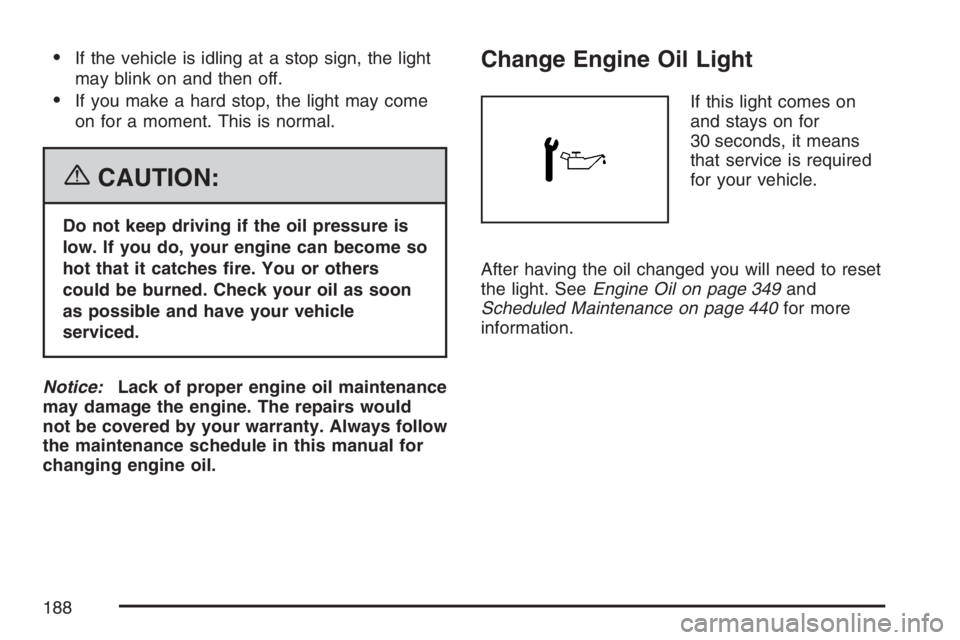
If the vehicle is idling at a stop sign, the light
may blink on and then off.
If you make a hard stop, the light may come
on for a moment. This is normal.
{CAUTION:
Do not keep driving if the oil pressure is
low. If you do, your engine can become so
hot that it catches �re. You or others
could be burned. Check your oil as soon
as possible and have your vehicle
serviced.
Notice:Lack of proper engine oil maintenance
may damage the engine. The repairs would
not be covered by your warranty. Always follow
the maintenance schedule in this manual for
changing engine oil.
Change Engine Oil Light
If this light comes on
and stays on for
30 seconds, it means
that service is required
for your vehicle.
After having the oil changed you will need to reset
the light. SeeEngine Oil on page 349and
Scheduled Maintenance on page 440for more
information.
188
Page 202 of 490
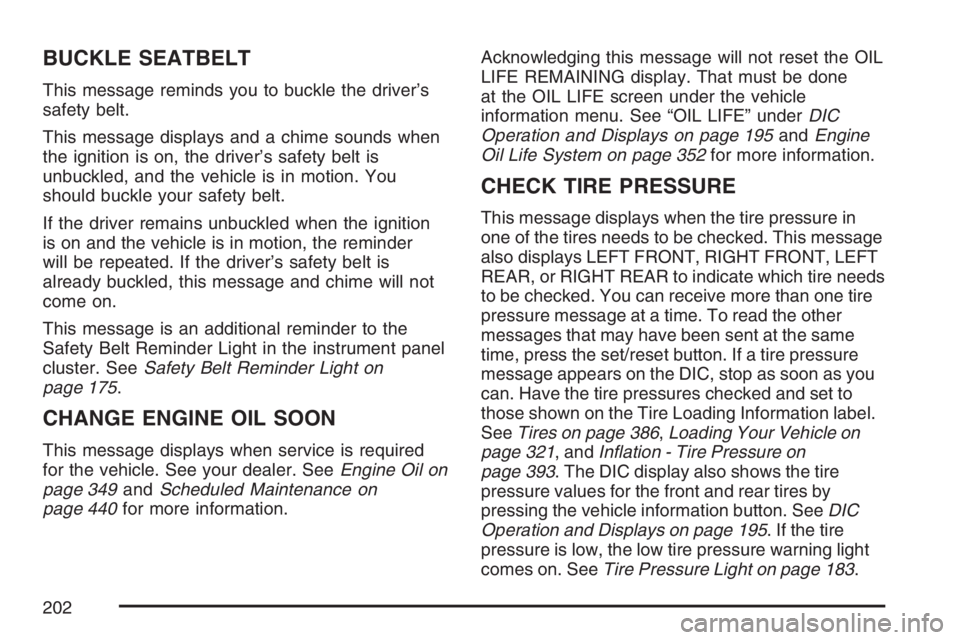
BUCKLE SEATBELT
This message reminds you to buckle the driverâs
safety belt.
This message displays and a chime sounds when
the ignition is on, the driverâs safety belt is
unbuckled, and the vehicle is in motion. You
should buckle your safety belt.
If the driver remains unbuckled when the ignition
is on and the vehicle is in motion, the reminder
will be repeated. If the driverâs safety belt is
already buckled, this message and chime will not
come on.
This message is an additional reminder to the
Safety Belt Reminder Light in the instrument panel
cluster. SeeSafety Belt Reminder Light on
page 175.
CHANGE ENGINE OIL SOON
This message displays when service is required
for the vehicle. See your dealer. SeeEngine Oil on
page 349andScheduled Maintenance on
page 440for more information.Acknowledging this message will not reset the OIL
LIFE REMAINING display. That must be done
at the OIL LIFE screen under the vehicle
information menu. See âOIL LIFEâ underDIC
Operation and Displays on page 195andEngine
Oil Life System on page 352for more information.
CHECK TIRE PRESSURE
This message displays when the tire pressure in
one of the tires needs to be checked. This message
also displays LEFT FRONT, RIGHT FRONT, LEFT
REAR, or RIGHT REAR to indicate which tire needs
to be checked. You can receive more than one tire
pressure message at a time. To read the other
messages that may have been sent at the same
time, press the set/reset button. If a tire pressure
message appears on the DIC, stop as soon as you
can. Have the tire pressures checked and set to
those shown on the Tire Loading Information label.
SeeTires on page 386,Loading Your Vehicle on
page 321, andIn�ation - Tire Pressure on
page 393. The DIC display also shows the tire
pressure values for the front and rear tires by
pressing the vehicle information button. SeeDIC
Operation and Displays on page 195. If the tire
pressure is low, the low tire pressure warning light
comes on. SeeTire Pressure Light on page 183.
202
Page 295 of 490
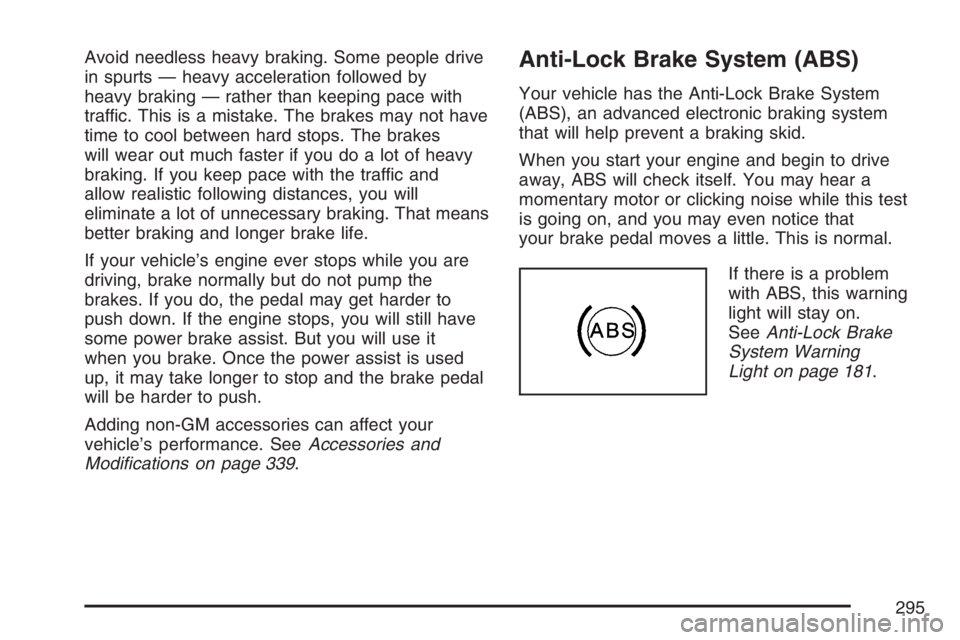
Avoid needless heavy braking. Some people drive
in spurts â heavy acceleration followed by
heavy braking â rather than keeping pace with
traffic. This is a mistake. The brakes may not have
time to cool between hard stops. The brakes
will wear out much faster if you do a lot of heavy
braking. If you keep pace with the traffic and
allow realistic following distances, you will
eliminate a lot of unnecessary braking. That means
better braking and longer brake life.
If your vehicleâs engine ever stops while you are
driving, brake normally but do not pump the
brakes. If you do, the pedal may get harder to
push down. If the engine stops, you will still have
some power brake assist. But you will use it
when you brake. Once the power assist is used
up, it may take longer to stop and the brake pedal
will be harder to push.
Adding non-GM accessories can affect your
vehicleâs performance. SeeAccessories and
Modi�cations on page 339.Anti-Lock Brake System (ABS)
Your vehicle has the Anti-Lock Brake System
(ABS), an advanced electronic braking system
that will help prevent a braking skid.
When you start your engine and begin to drive
away, ABS will check itself. You may hear a
momentary motor or clicking noise while this test
is going on, and you may even notice that
your brake pedal moves a little. This is normal.
If there is a problem
with ABS, this warning
light will stay on.
SeeAnti-Lock Brake
System Warning
Light on page 181.
295
Page 313 of 490
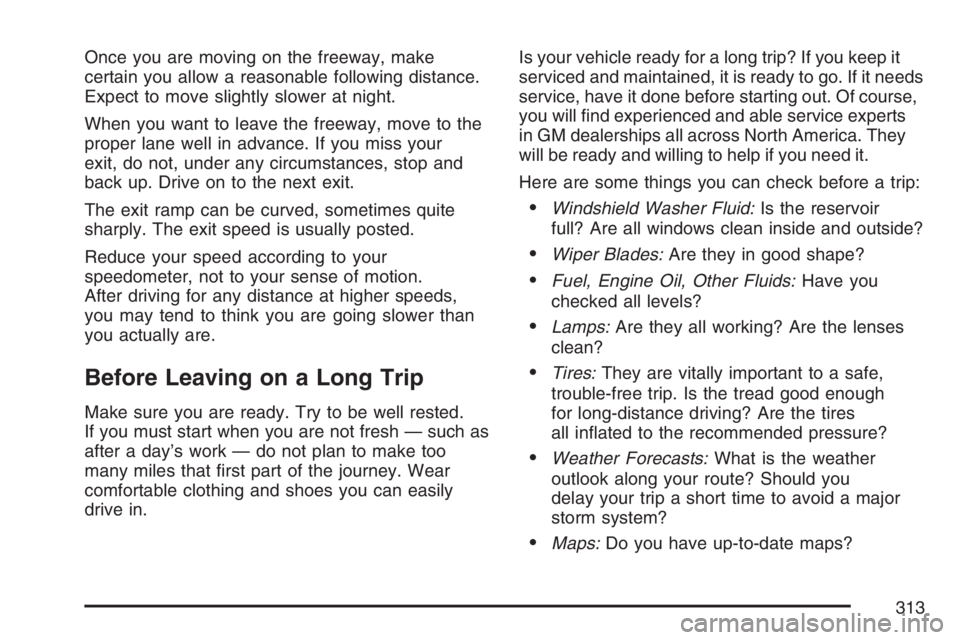
Once you are moving on the freeway, make
certain you allow a reasonable following distance.
Expect to move slightly slower at night.
When you want to leave the freeway, move to the
proper lane well in advance. If you miss your
exit, do not, under any circumstances, stop and
back up. Drive on to the next exit.
The exit ramp can be curved, sometimes quite
sharply. The exit speed is usually posted.
Reduce your speed according to your
speedometer, not to your sense of motion.
After driving for any distance at higher speeds,
you may tend to think you are going slower than
you actually are.
Before Leaving on a Long Trip
Make sure you are ready. Try to be well rested.
If you must start when you are not fresh â such as
after a dayâs work â do not plan to make too
many miles that �rst part of the journey. Wear
comfortable clothing and shoes you can easily
drive in.Is your vehicle ready for a long trip? If you keep it
serviced and maintained, it is ready to go. If it needs
service, have it done before starting out. Of course,
you will �nd experienced and able service experts
in GM dealerships all across North America. They
will be ready and willing to help if you need it.
Here are some things you can check before a trip:
Windshield Washer Fluid:Is the reservoir
full? Are all windows clean inside and outside?
Wiper Blades:Are they in good shape?
Fuel, Engine Oil, Other Fluids:Have you
checked all levels?
Lamps:Are they all working? Are the lenses
clean?
Tires:They are vitally important to a safe,
trouble-free trip. Is the tread good enough
for long-distance driving? Are the tires
all in�ated to the recommended pressure?
Weather Forecasts:What is the weather
outlook along your route? Should you
delay your trip a short time to avoid a major
storm system?
Maps:Do you have up-to-date maps?
313
Page 319 of 490
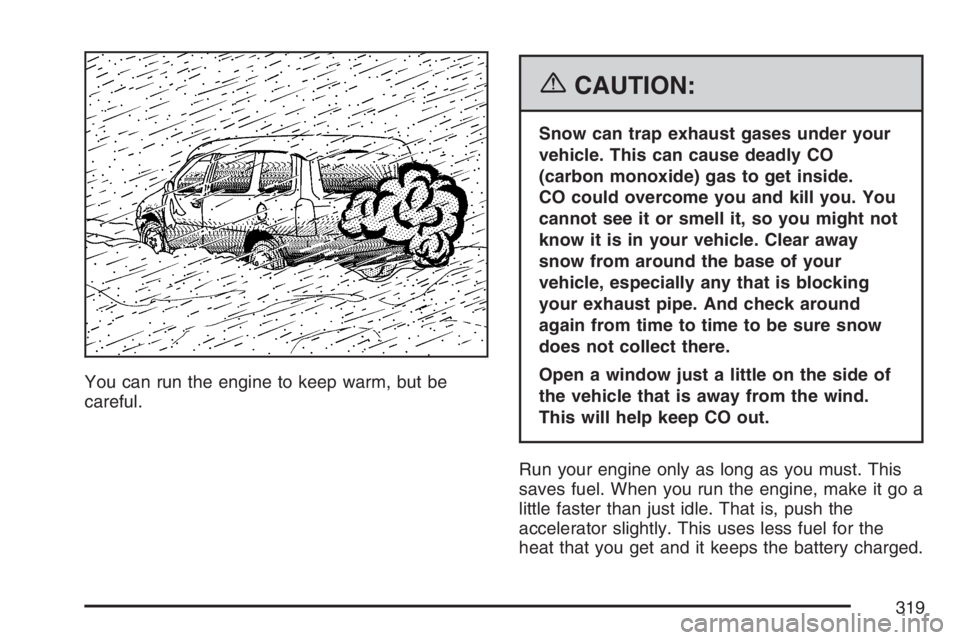
You can run the engine to keep warm, but be
careful.
{CAUTION:
Snow can trap exhaust gases under your
vehicle. This can cause deadly CO
(carbon monoxide) gas to get inside.
CO could overcome you and kill you. You
cannot see it or smell it, so you might not
know it is in your vehicle. Clear away
snow from around the base of your
vehicle, especially any that is blocking
your exhaust pipe. And check around
again from time to time to be sure snow
does not collect there.
Open a window just a little on the side of
the vehicle that is away from the wind.
This will help keep CO out.
Run your engine only as long as you must. This
saves fuel. When you run the engine, make it go a
little faster than just idle. That is, push the
accelerator slightly. This uses less fuel for the
heat that you get and it keeps the battery charged.
319
Page 352 of 490

Notice:Use only engine oil identi�ed as
meeting GM Standard GM6094M and showing
the American Petroleum Institute Certi�ed
For Gasoline Engines starburst symbol. Failure
to use the recommended oil can result in
engine damage not covered by your warranty.
GM Goodwrench
®oil meets all the requirements
for your vehicle.
Engine Oil Additives
Do not add anything to the oil. The recommended
oils with the starburst symbol that meet GM
Standard GM6094M are all you will need for good
performance and engine protection.
Engine Oil Life System
When to Change Engine Oil
Your vehicle has a computer system that lets you
know when to change the engine oil and �lter.
This is based on engine revolutions and engine
temperature, and not on mileage. Based on driving
conditions, the mileage at which an oil change
will be indicated can vary considerably. For the oil
life system to work properly, you must reset the
system every time the oil is changed.When the system has calculated that oil life has
been diminished, it will indicate that an oil change
is necessary. A change engine oil light and a
CHANGE ENGINE OIL SOON message will come
on. Change your oil as soon as possible within
the next 600 miles (1 000 km). It is possible that, if
you are driving under the best conditions, the oil
life system may not indicate that an oil change
is necessary for over a year. However, your engine
oil and �lter must be changed at least once a
year and at this time the system must be reset.
Your dealer has GM-trained service people
who will perform this work using genuine GM parts
and reset the system. It is also important to
check your oil regularly and keep it at the
proper level.
If the system is ever reset accidentally, you must
change your oil at 3,000 miles (5 000 km)
since your last oil change. Remember to reset the
oil life system whenever the oil is changed.
352
Page 357 of 490
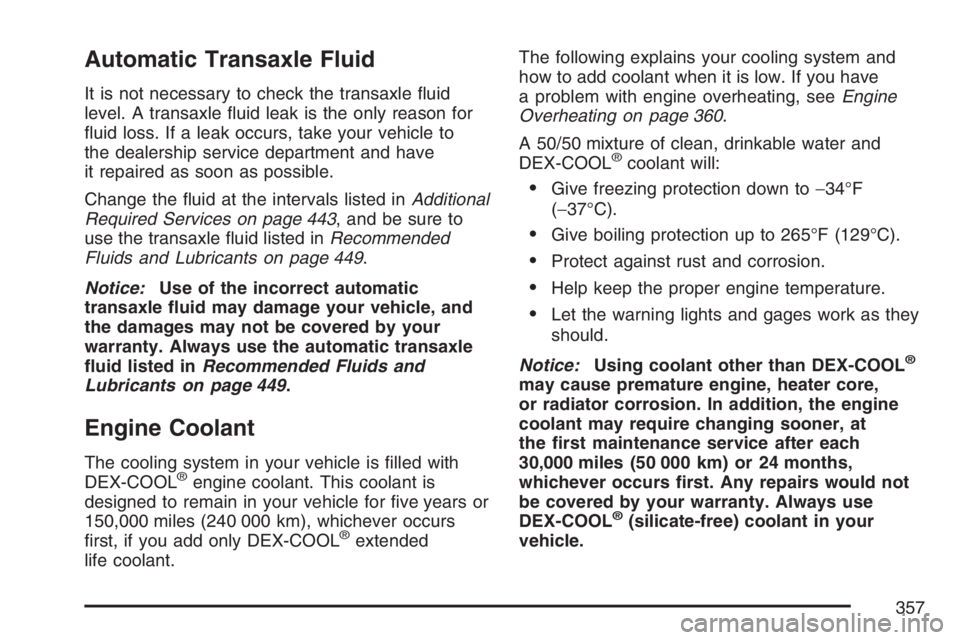
Automatic Transaxle Fluid
It is not necessary to check the transaxle �uid
level. A transaxle �uid leak is the only reason for
�uid loss. If a leak occurs, take your vehicle to
the dealership service department and have
it repaired as soon as possible.
Change the �uid at the intervals listed inAdditional
Required Services on page 443, and be sure to
use the transaxle �uid listed inRecommended
Fluids and Lubricants on page 449.
Notice:Use of the incorrect automatic
transaxle �uid may damage your vehicle, and
the damages may not be covered by your
warranty. Always use the automatic transaxle
�uid listed inRecommended Fluids and
Lubricants on page 449.
Engine Coolant
The cooling system in your vehicle is �lled with
DEX-COOL®engine coolant. This coolant is
designed to remain in your vehicle for �ve years or
150,000 miles (240 000 km), whichever occurs
�rst, if you add only DEX-COOL
®extended
life coolant.The following explains your cooling system and
how to add coolant when it is low. If you have
a problem with engine overheating, seeEngine
Overheating on page 360.
A 50/50 mixture of clean, drinkable water and
DEX-COOL
®coolant will:
Give freezing protection down toâ34°F
(â37°C).
Give boiling protection up to 265°F (129°C).
Protect against rust and corrosion.
Help keep the proper engine temperature.
Let the warning lights and gages work as they
should.
Notice:Using coolant other than DEX-COOL
®
may cause premature engine, heater core,
or radiator corrosion. In addition, the engine
coolant may require changing sooner, at
the �rst maintenance service after each
30,000 miles (50 000 km) or 24 months,
whichever occurs �rst. Any repairs would not
be covered by your warranty. Always use
DEX-COOL
®(silicate-free) coolant in your
vehicle.
357
Page 440 of 490
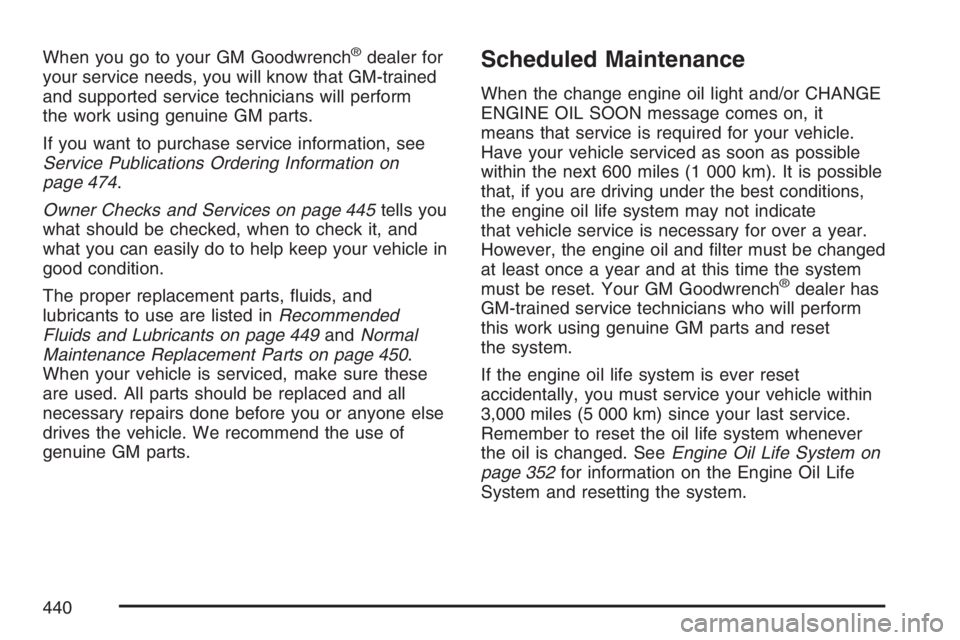
When you go to your GM Goodwrench®dealer for
your service needs, you will know that GM-trained
and supported service technicians will perform
the work using genuine GM parts.
If you want to purchase service information, see
Service Publications Ordering Information on
page 474.
Owner Checks and Services on page 445tells you
what should be checked, when to check it, and
what you can easily do to help keep your vehicle in
good condition.
The proper replacement parts, �uids, and
lubricants to use are listed inRecommended
Fluids and Lubricants on page 449andNormal
Maintenance Replacement Parts on page 450.
When your vehicle is serviced, make sure these
are used. All parts should be replaced and all
necessary repairs done before you or anyone else
drives the vehicle. We recommend the use of
genuine GM parts.Scheduled Maintenance
When the change engine oil light and/or CHANGE
ENGINE OIL SOON message comes on, it
means that service is required for your vehicle.
Have your vehicle serviced as soon as possible
within the next 600 miles (1 000 km). It is possible
that, if you are driving under the best conditions,
the engine oil life system may not indicate
that vehicle service is necessary for over a year.
However, the engine oil and �lter must be changed
at least once a year and at this time the system
must be reset. Your GM Goodwrench
®dealer has
GM-trained service technicians who will perform
this work using genuine GM parts and reset
the system.
If the engine oil life system is ever reset
accidentally, you must service your vehicle within
3,000 miles (5 000 km) since your last service.
Remember to reset the oil life system whenever
the oil is changed. SeeEngine Oil Life System on
page 352for information on the Engine Oil Life
System and resetting the system.
440
Page 441 of 490
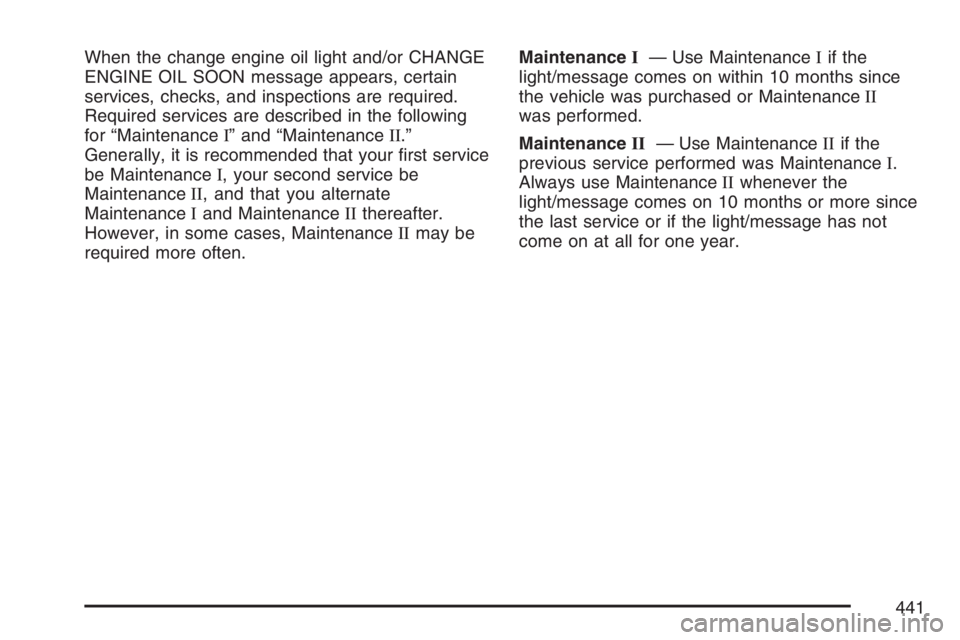
When the change engine oil light and/or CHANGE
ENGINE OIL SOON message appears, certain
services, checks, and inspections are required.
Required services are described in the following
for âMaintenanceIâ and âMaintenanceII.â
Generally, it is recommended that your �rst service
be MaintenanceI, your second service be
MaintenanceII, and that you alternate
MaintenanceIand MaintenanceIIthereafter.
However, in some cases, MaintenanceIImay be
required more often.MaintenanceIâ Use MaintenanceIif the
light/message comes on within 10 months since
the vehicle was purchased or MaintenanceII
was performed.
MaintenanceIIâ Use MaintenanceIIif the
previous service performed was MaintenanceI.
Always use MaintenanceIIwhenever the
light/message comes on 10 months or more since
the last service or if the light/message has not
come on at all for one year.
441
Page 479 of 490
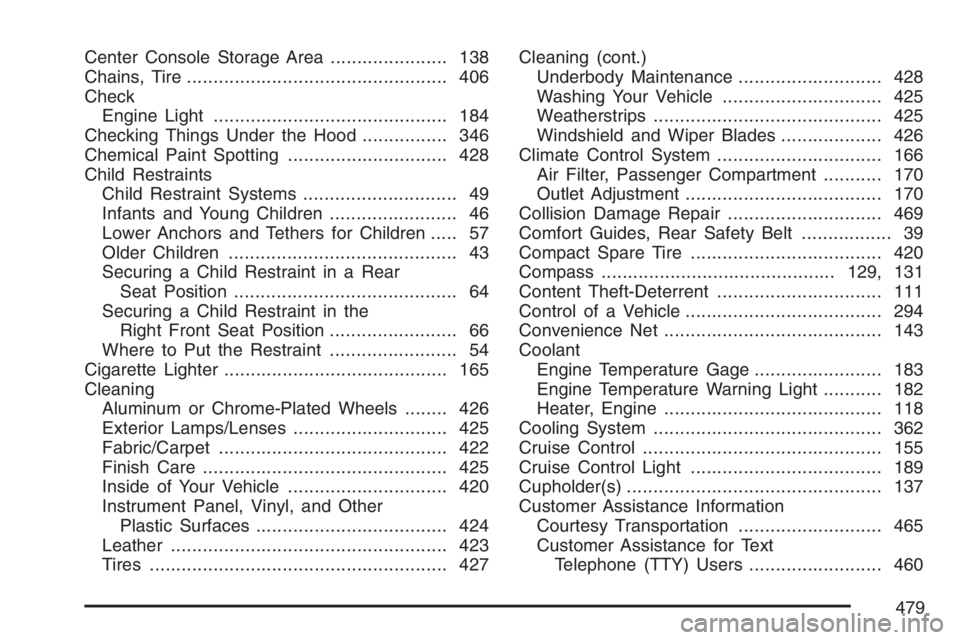
Center Console Storage Area...................... 138
Chains, Tire................................................. 406
Check
Engine Light............................................ 184
Checking Things Under the Hood................ 346
Chemical Paint Spotting.............................. 428
Child Restraints
Child Restraint Systems............................. 49
Infants and Young Children........................ 46
Lower Anchors and Tethers for Children..... 57
Older Children........................................... 43
Securing a Child Restraint in a Rear
Seat Position.......................................... 64
Securing a Child Restraint in the
Right Front Seat Position........................ 66
Where to Put the Restraint........................ 54
Cigarette Lighter.......................................... 165
Cleaning
Aluminum or Chrome-Plated Wheels........ 426
Exterior Lamps/Lenses............................. 425
Fabric/Carpet........................................... 422
Finish Care.............................................. 425
Inside of Your Vehicle.............................. 420
Instrument Panel, Vinyl, and Other
Plastic Surfaces.................................... 424
Leather.................................................... 423
Tires........................................................ 427Cleaning (cont.)
Underbody Maintenance........................... 428
Washing Your Vehicle .............................. 425
Weatherstrips........................................... 425
Windshield and Wiper Blades................... 426
Climate Control System............................... 166
Air Filter, Passenger Compartment........... 170
Outlet Adjustment..................................... 170
Collision Damage Repair............................. 469
Comfort Guides, Rear Safety Belt................. 39
Compact Spare Tire.................................... 420
Compass............................................129, 131
Content Theft-Deterrent............................... 111
Control of a Vehicle..................................... 294
Convenience Net......................................... 143
Coolant
Engine Temperature Gage........................ 183
Engine Temperature Warning Light........... 182
Heater, Engine......................................... 118
Cooling System........................................... 362
Cruise Control............................................. 155
Cruise Control Light.................................... 189
Cupholder(s)................................................ 137
Customer Assistance Information
Courtesy Transportation........................... 465
Customer Assistance for Text
Telephone (TTY) Users......................... 460
479